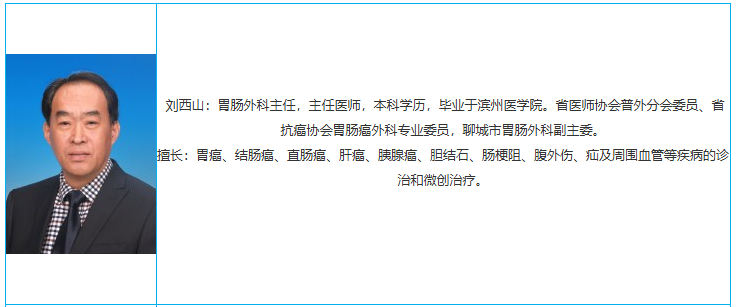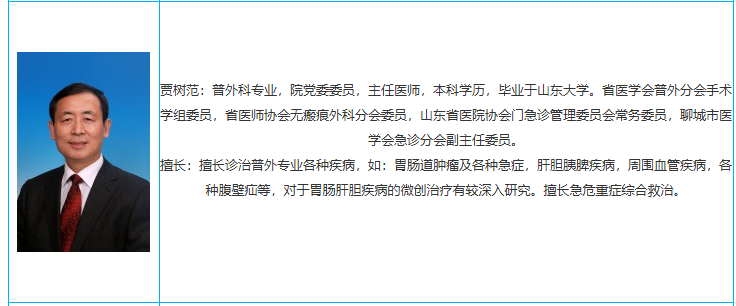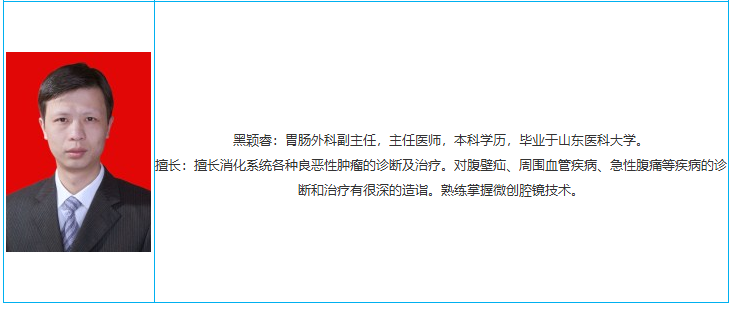- Date:2022-09-20
Gastrointestinal Surgery Department of the Second People's Hospital of Liaocheng City, Shandong Province is an independent and professional department separated from General Surgery Department, and it is the largest gastrointestinal surgical disease treatment centre in northwestern Shandong Province and southern Hebei Province, integrating clinical, teaching and scientific research, and it is mainly responsible for diagnosis and treatment of benign and malignant tumors of gastrointestinal diseases (gastrointestinal cancers, gastrointestinal mesenchymal tumors and gastrointestinal polyps, etc.), appendicitis, various kinds of hiatus hernias, perforation of the gastrointestinal tract, intestinal obstruction, gastrointestinal hemorrhage, and abdominal injuries. At the same time, the department is responsible for the teaching internship of clinical medical students of Taishan Medical College, and it is also the base for the doctors of the surrounding county hospitals and township hospitals for further study and standardised training of resident doctors. Department of strong technical force, excellent nursing, is the first batch of hospital quality care wards, the existing 9 doctors, 14 nurses, 45 beds. The head of the department is Dr Liu Xishan, a famous general surgeon in northwestern Shandong Province and southern Hebei Province. Liu Xishan, chief physician, director of general surgery, director of gastrointestinal surgery, Linqing City Top Ten Medical Pace-setter, director of the surgical teaching and research department of the Affiliated Hospital of Taishan Medical College, part-time professor, member of the Chinese Anti-cancer Association, member of Shandong Province Anti-cancer Association of gastrointestinal cancer surgery, member of the Shandong Provincial Physicians Association of General Surgery, member of Shandong Provincial Wound Ostomy Professional Committee.
Characteristic techniques:
1、Laparoscopic radical surgery for colorectal cancer and anal preservation surgery for low rectal cancer.
Laparoscopic radical surgery for colorectal cancer is a micro-innovative technology developed in recent years, which is less traumatic, less painful, quicker recovery, and the effect of radical treatment is completely up to or even better than that of open radical surgery for colorectal cancer. In recent years, with the improvement of surgical technology and surgical instruments, we have actively carried out low rectal cancer anus-preserving surgery, so that the majority of rectal cancer patients are free from the pain of fistula diversion, which greatly improves the quality of life.
2. Standardised surgery for gastric cancer.
Our department actively advocates and carries out standardised radical surgery for gastric cancer in northwestern Shandong and southern Hebei, with lymphatic sweeping and pulsating, thorough, complete and clean resection of the lesion, which greatly improves the time of tumour-free survival and prolongs the patients' life.
3、Tension free hernia repair.
Abdominal wall hernia is a common and frequent disease in abdominal surgery, which brings pain to patients and affects the life of the majority of hernia patients. For many years, traditional suture repair surgery has been used, which is painful, with high recurrence rate and many complications. Over the past 10 years, we have applied a variety of repair mesh, according to the patient's different conditions for different ways of tension-free hernia repair, greatly reducing the pain and complications, and reducing the recurrence rate. Especially in recent years, we have actively carried out laparoscopic hernia repair, which is more minimally invasive, less painful, earlier out of bed, and the length of hospital stay is greatly reduced.
Our principles are rigour and refinement, unity and progress. We wish our patients a speedy recovery.






 鲁ICP备11009722号-4
鲁ICP备11009722号-4 